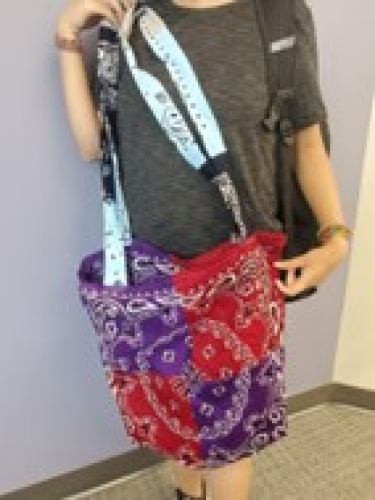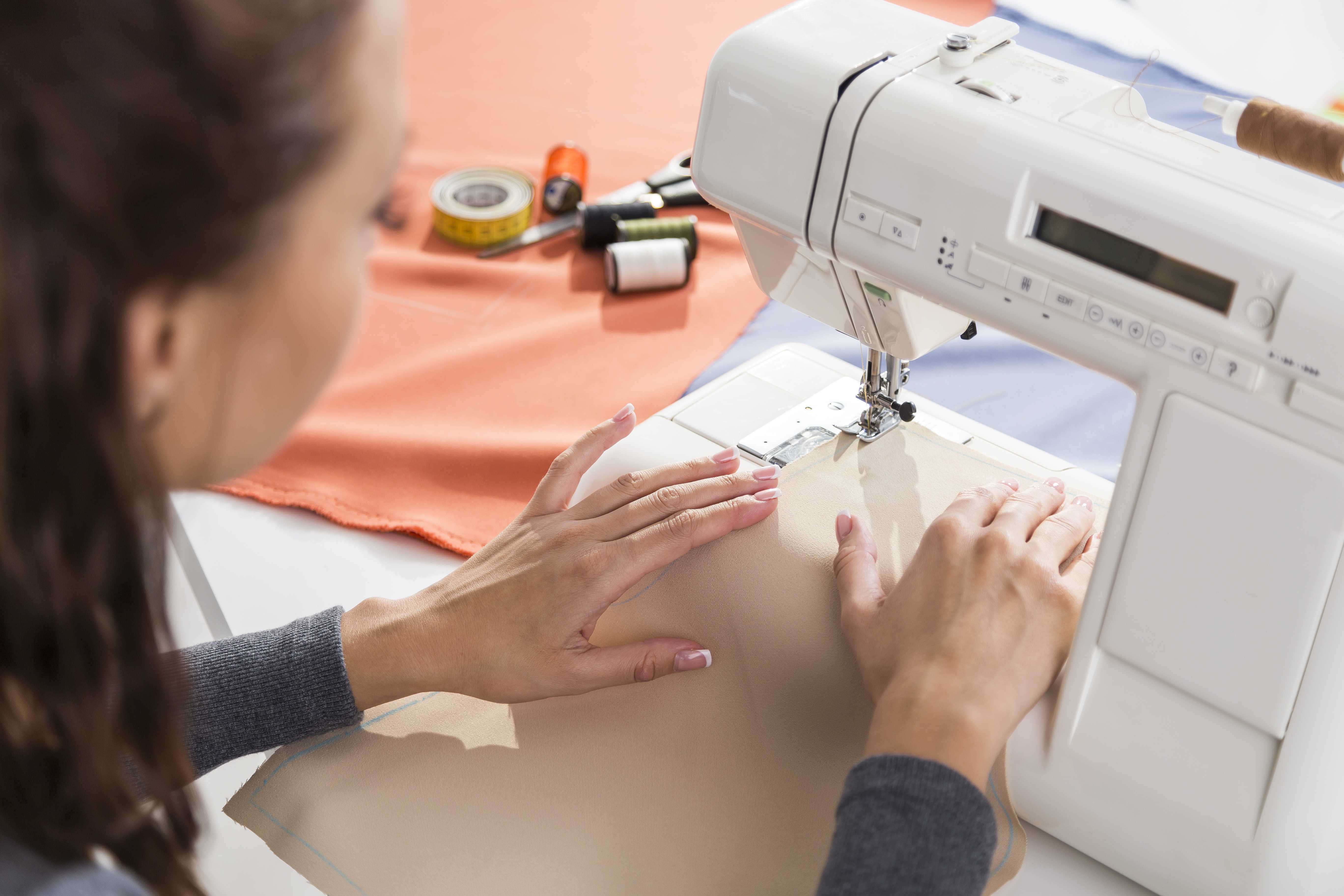Home
Events Calendar
Beginner Sewing for Busy People– Sewing Machine Basics – Adults: Age 16+
Friday nights 5:30 - 8:00 PM
Mable House Arts Center - 5239 Floyd Road SW, Mableton, GA 30126
4-Class Series: Fridays, October18th, and 25th, November 1st, and 8th.
You are busy but want to create with the sewing machine. This beginner class is for you!
Learn how the sewing machine works and how to measure, stitch and create home decor items and bags from fabric using a sewing machine. Students should bring their own sewing machines and instructional manual. The sewing machine used should be less than 30 years old and confirmed to be in good working order before the class begins. No repair service is offered. A limited number of machines are available for $20 per term. Please contact the instructor one week prior to class to rent a sewing machine. A supply list will be provided for additional supplies needed. Students will be shown how to develop a “Sewing Supply Box” and want to purchase their own items for it. Students will be asked to bring their own fabric as described, typically 100% cotton.
In person instruction from other providers in the Atlanta area ranges from $300 - $400 for a 4-session class, so this is priced below market rates.
Skill Development
o Safety Skills
o Pattern Layout
o Stitch Control / Speed-Pedal Control
o Elastic/Cord Casings
Class 1 : Fabric - Pocket Tissue Holder Skill: Stitching straight stitches, 3-D construction
This project uses two small fabric pieces each smaller than 1 foot (12 inches), so scrap material can be used or a “fat quarter” commonly sold at Walmart, Dollar Tree and Hobby Lobby. Pick fabrics that complement each other because one fabric will serve as a liner. Consider a print for the outside and a solid color for the inside. Here is a video tutorial: Fabric Pocket Tissue Holder
Fabric 1: 100% Cotton Print (no knits): 12 inch square or 1 “fat quarter”
Fabric 2: 100% Cotton Solid (no knits): 12 inch square or 1 “fat quarter”
Thread: Matching thread (will show as a top-stitch on the edging)
Class 2: Fabric Bowl Cozy Skill: Sewing straight stitches, 3-D construction
This project uses two small fabric pieces each smaller than 1 foot (12 inches), but it is reversible, so choose prints/colors that you like for both sides. This bowl cozy will be used to keep food warm, so consider colors that won’t stain if soup gets spilled on them. All materials including thread should be 100% cotton to heat in the microwave (no polyester thread). Here is a video tutorial: DIY Bowl Cozy
Fabric 1: 1 foot (12 inches) 100% Cotton (No Knits). Select two color coordinating fabrics (print/solid or print/print)
Fabric 2: 1 foot (12 inches) 100% Cotton (no knits).
Batting: Must be 100% Cotton to use in the microwave.
Thread: 100% Cotton (no polyester thread) in coordinating color (will show as a top-stitch)
Class 3 - Rod Curtains. This project will require you to pre-measure the window in which you plan to hang the curtains. A favorite trick I like is to use Shower Curtains for fabric, especially if you have windows in your bathroom and want to match the decor. I’ve used “retired” fabric sheer shower curtains for front door side panel privacy drapes as well. You can repurpose a beloved shower curtain this way.
How to Measure Fabric for Curtains: Determine the length you want your curtains to be by measuring from the curtain rod to the spot where you’d like the bottom of the curtain to fall. Add 18” to this number; this is the length of fabric you need for each curtain panel. (The extra 18” will give you enough fabric to hem each panel, plus allow for fabric shrinking during pre-washing.)
Now, determine the width you need. For this tutorial, we’re using Linen Cotton Canvas which has a width of 54”. If you don’t need a particularly full or gathered curtain, you may decide that one width of fabric is enough for your panel. If you prefer a more gathered look, you’ll want the fabric to be anywhere from 1.5-3 times wider than the actual window width. (Source: Spoonflower Blog: Your Guide to Sewing the Perfect Curtains.
Fabric: 100% Cotton or Lightweight Duck Fabric for sturdier curtains. No Knits. - See measurement guide above.
Thread: Coordinating thread.
Curtain Rod: It is a good idea to either measure the diameter of your curtain rod or bring the rod with you to class. You will be creating a rod pocket to fit this curtain rod.
Class 4: Bandana Tote Bag
This project will use 4-5 bandanas or “fat quarters” to make a trendy colorful tote bag.
When purchasing bandanas or “fat quarters” think about the color layout and plan to have an even number of colors to contrast. For example, choose either two (2) alternate colors or choose four (4). Do not choose an odd number.
Also, if you are using Bandanas you will want to purchase one (1) extra of each color to make the strap.
Fabric:
2 Color Patterns: Purchase 4 of all materials (either individual bandanas or fat quarters)
4 Color Patterns: Purchase 2 of all materials (either individual bandanas or fat quarters)
Thread: Choose one color that will coordinate with all pattern choices. Examples: Bandana Bag on Left. Two bags made with fat quarters on the right.

GENERAL Supplies Needed for Student to provide:
- Sewing Kit (see details below)
- Mechanical Sewing Machine: Students may bring their own or pay a small use for provided machines ($20 per course)
- Sewing Machine Manual w/Instructions on how to use (each machine is different and we may need to reference the manual. You can find these online if you do not have it.
- Preferred fabrics that student wants for napkins, pillow, bedding pillowcase and/or tote bag, 1 yard in length for most projects. (Optional: can be purchased after first class.)
- All-purpose thread in assorted colors (primary colors White, Black, Red, Blue, Yellow and any student favorites, Pink, Green, Orange Purple, etc.)
Sewing Kit
If you don’t have everything on the list below, just be sure you at least have the parts included in a Basic Sewing Kit like this one from Singer: Singer Beginners Sewing Kit
- Sewing box (can be a box of plastic, cardboard or a basket w/lid)
- Extra bobbins to fit your sewing machine
- Sewing Machine needles (Size 80/12 or 90/14)
- Pincushion for straight pins or Magnetic Pin Holder
- Fabric Scissors (any brand only use these on fabric)
- Regular scissors (any brand only use these for paper)
- Measuring Tape
- Hem Gauge
- Hand sewing needles
- Pins (40-50 straight pins)
- Seam ripper w/cover
- Optional: Pinking shears to finish inside edges
Sewing Machine Requirements (These are suggestions for the most appropriate sewing machine for this class. These are basic machines with options to select simple stitching. Elaborate electronic or embroidery machines, sergers, etc will be too complicated for these projects. Simple is good.)
- Portable/easy-to-carry
- Zig-zag stitching
- Back-stitching optionGood working condition (is more important than the age of the machine.) Old machines kept in good condition or tuned-up in the shop should be fine.
- Pressure foot control
- Drop-in Bobbin
- Speed control adjustment (to slow down or speed up stitch speed)
- Zig-zag stitching
- Back-stitching option
- Button-hole option/foot attachment
- Sewing Machine needles (Size 80/12 or 90/14)
- Zipper-foot included
Popular Beginner Sewing Machine Models:
- Brother XM2701 Lightweight Sewing Machine
- Janome: Easy-to-Use Sewing Machine w/Metal Frame
- Singer M3220 (sold at Walmart - or a similar model from another retailer.)
Note: Look for features like Easy-to-thread, Reverse/Backstitch, 8+ stitch selector (including buttonhole, zig-zag stitch), adjustable stitch width and length selection.

